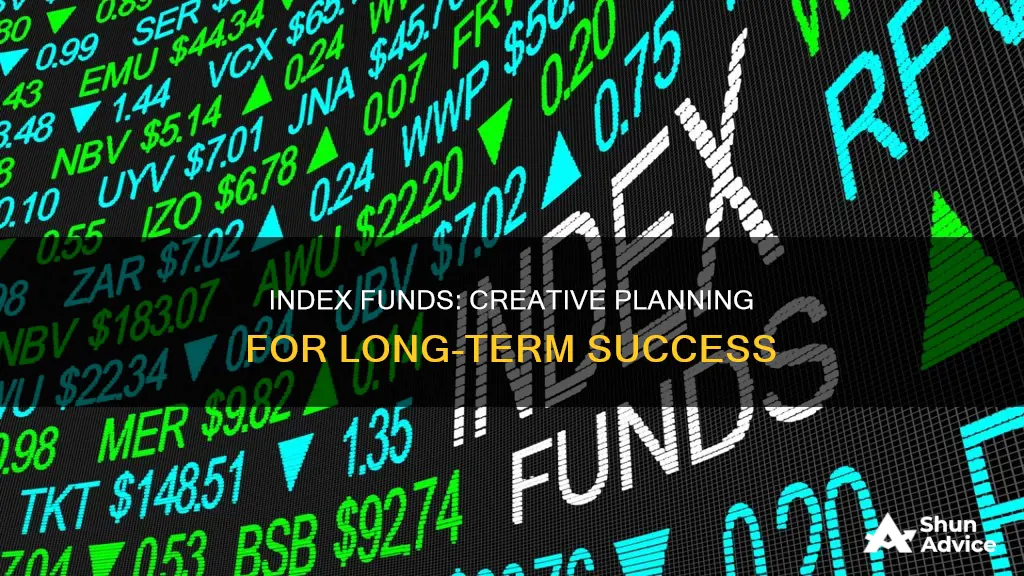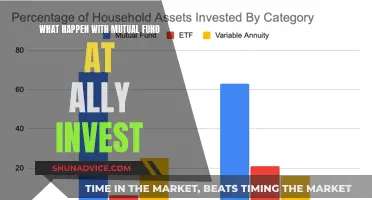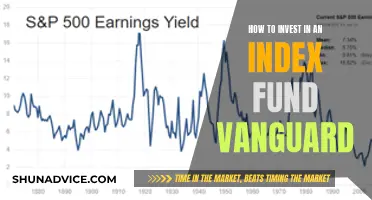
Index funds are a type of mutual or exchange-traded fund (ETF) that tracks the performance of a market index, such as the S&P 500, by holding the same stocks or bonds or a representative sample of them. They are a low-cost, easy way to build wealth and are therefore popular with retirement investors.
Index funds are considered a passive investment strategy as they don't require active decisions on which investments to buy or sell. They are also less expensive than actively managed funds and typically carry less risk than individual stocks.
1. Decide on your investment goals and risk tolerance.
2. Research different types of index funds such as equity index funds, bond index funds, international index funds, and sector-specific index funds.
3. Choose an online brokerage platform or investment platform that suits your needs.
4. Open and fund an account with your chosen platform.
5. Select an index fund that aligns with your goals and has low fees and a good performance history.
6. Buy shares of your chosen fund through the platform.
7. Monitor your investments periodically and make adjustments as needed to ensure they remain aligned with your financial goals.
It is important to note that while index funds offer diversification and lower fees, they may not be suitable for everyone as they lack the flexibility to pivot away from market shifts. Consulting a financial advisor can help determine if index funds are the right investment choice for your portfolio.
What You'll Learn

Understand the benefits of index funds
Index funds are a great investment vehicle for those looking to build wealth over the long term. Here are some of the key benefits of investing in index funds:
Broad Diversification
Index funds provide instant diversification to an investor's portfolio by investing in a basket of securities that track a particular market index, such as the S&P 500. This diversification helps to minimise the risk of losing money as it ensures that the portfolio's performance is not overly dependent on the fortunes of any single company.
Low Costs
Index funds have lower costs compared to other actively managed funds. They have lower management fees as they are passively managed, i.e., they simply mirror the performance of the underlying index. Additionally, index funds have lower transaction costs as they trade in and out of securities less frequently, resulting in lower taxes on capital gains.
Attractive Returns
Index funds have consistently outperformed actively managed funds over the long term. Even renowned investors like Warren Buffett have championed the use of index funds, famously winning a $1 million bet that an S&P 500 index fund would beat the returns of an actively managed hedge fund over a 10-year period.
Low Risk
Index funds are considered a low-risk investment option as they aim to match the performance of the market or a specific benchmark index. This passive management strategy means that index funds don't need to actively decide which investments to buy or sell, reducing the likelihood of significant losses.
Tax Efficiency
Index funds are tax-efficient as they generate less taxable income compared to other funds. This is because they buy new lots of securities whenever investors put money into the fund, allowing them to choose the lots with the lowest capital gains when selling, minimising the tax burden passed on to shareholders.
Ease of Investment
Index funds are easy to invest in and are accessible to both beginner and experienced investors. They can be purchased through a brokerage firm or a mutual fund company, and some index funds have low or no minimum investment requirements.
Overall, index funds offer a simple, low-cost, and effective way to build wealth over time, making them a popular choice for investors, especially those saving for retirement.
How to Choose a Qualified Opportunity Fund for Investing
You may want to see also

Know the types of index funds
Index funds are a great investment for building wealth over the long term. They are a group of stocks that mirror the performance of an existing stock market index, such as the Standard & Poor's 500 index. Here are some of the types of index funds:
Broad Market Index Funds
Broad market index funds aim to capture the majority of an investable market, which could be stocks, bonds, or other investable assets. While many index funds track a portion of the overall stock market, broad market index funds will include companies from both the large-cap and small-cap universe. Examples include the Vanguard Total Stock Market ETF and the Schwab U.S. Broad Market ETF.
Market Cap Index Funds
Market cap index funds invest based on specific market capitalization ranges. A company's market cap is equal to the total value of its outstanding shares, and companies can be divided based on these values. Large-cap funds, such as funds that track the S&P 500, generally hold companies with market caps above $10 billion, while small-cap funds tend to hold companies with market caps below $2 billion. Examples include the Fidelity 500 Index Fund and the Vanguard Mid-Cap ETF.
Equal Weight Index Funds
Most stock index funds are weighted according to their market cap, but equal weight index funds solve the issue of a company becoming overvalued and accounting for a significant portion of the fund's assets. Each holding in the fund makes up roughly the same percentage of fund assets. Examples include the Invesco S&P 500 Equal Weight ETF and the Direxion Nasdaq-100 Equal Weighted Index Shares.
Fixed Income/Debt Index Funds
Fixed income or debt index funds track bond indices, allowing them to charge low expense ratios compared to actively managed funds. Bonds can play an important role in your portfolio, especially during retirement. Examples include the Vanguard Long-Term Bond ETF and the iShares 1-5 Year Investment Grade Corporate Bond ETF.
Sector-Based Index Funds
Sector-based index funds are great if you have a specific view on a certain area of the economy. For example, you might buy a fund based on the technology sector or a fund focused on financials if you think rates will continue to rise. Examples include the Consumer Discretionary Select Sector SPDR Fund and the Fidelity MSCI Financials Index ETF.
International Index Funds
International index funds are a simple way to gain exposure to geographic areas outside the U.S. You can purchase a diversified portfolio of companies from a specific country or region through a single fund. Examples include the Vanguard FTSE Emerging Markets ETF and the iShares Core MSCI Total International Stock ETF.
Socially Responsible Index Funds
Socially responsible index funds have become increasingly popular as investors care more about how their money is invested. Some companies have increased their focus on environmental, social, and governance issues and are included in indexes that track stocks with that appeal. Examples include the Vanguard ESG U.S. Stock ETF and the iShares Global Clean Energy ETF.
Tax Managed Mutual Funds: When to Invest for Maximum Benefits
You may want to see also

Choose the right fund for your index
Once you've decided on your investment goals and timeline, you can select an index fund that suits your needs. Here are some factors to consider when choosing the right fund for your index:
- Performance and tracking error: Choose a fund that closely tracks the performance of the index. Compare the returns of the fund with the benchmark index to assess how well it mirrors the index's performance.
- Costs and fees: Index funds typically have lower fees than actively managed funds, but they still vary among index funds. Consider the expense ratio, investment minimum, account minimum, sales loads, and expense ratios. Compare fees across different funds to find the most cost-effective option.
- Restrictions and limitations: Some index funds have minimum investment requirements or other limitations. Ensure you understand any restrictions before investing.
- Fund provider and other offerings: Consider whether the fund provider offers other index funds that align with your investment goals. Diversifying your portfolio by investing in multiple index funds from the same provider can streamline your investment process.
- Liquidity and trading costs: Assess the liquidity of the fund and consider the trading costs involved. Larger funds often offer better liquidity and lower trading costs.
- Tax implications: Understand the tax implications of investing in the index fund, especially if you're investing in a taxable brokerage account. Consider the tax-cost ratio and consult a financial advisor to optimise your tax strategy.
- Risk tolerance and volatility: Evaluate your risk tolerance and the volatility of the index fund. If you're closer to retirement or have a lower risk appetite, you may prefer the stability of a bond index fund over a stock index fund.
- Sector and industry focus: Decide if you want to invest in a broad market index fund or focus on specific sectors or industries. You can find index funds that track technology, healthcare, energy, or other sectors.
- Geographic focus: Determine whether you want to invest in domestic or international index funds. Some funds focus on specific regions or global markets outside the US.
- Fund size: Larger funds may offer economies of scale and lower fees. However, smaller funds may provide more niche investment opportunities or specialised strategies.
- Fund manager reputation and background: Research the background and reputation of the fund manager. Assess their track record and expertise in managing index funds.
- Diversification and asset allocation: Consider how the index fund fits into your overall portfolio and investment strategy. Diversification across different asset classes, sectors, and geographic regions can help manage risk.
Best Funds to Maximize Your 401k Returns
You may want to see also

Buy index fund shares
Once you have decided on your investment goals and chosen the right fund strategy for your timeline, you can start buying index fund shares. Here is a step-by-step guide:
- Choose an investment platform: Select an online brokerage or investment platform that provides strong customer support and offers robust research and analytical tools.
- Open and fund an account: Provide personal information, set up login credentials, complete a questionnaire about investment goals and risk tolerance, and deposit funds through a bank transfer.
- Select an index fund: Research different funds to understand their performance history, management fees, and the indexes they track. Consider diversifying your portfolio by investing in several index funds.
- Buy shares: With your account funded, purchase shares of your chosen fund through the website or app of your chosen platform.
- Monitor and adjust: While index funds are typically long-term investments, periodically review your portfolio to ensure it remains aligned with your financial goals.
Where to buy index fund shares
You can buy index fund shares directly from a mutual fund company or a brokerage. You can also buy them through a robo-advisor, which will manage and rebalance a portfolio of diversified, low-cost index funds for you.
Another option is to open an account with a mutual fund company that offers an index fund you're interested in. This may be more convenient if you plan to invest only in mutual funds. However, if you require sophisticated stock research and screening tools, a discount broker that also sells index funds might be a better choice.
Costs of buying index fund shares
When deciding where to buy index fund shares, consider the trading costs. Mutual fund commissions are typically higher than stock trading commissions, while ETFs may be subject to commission or transaction fees. Some brokers may also charge extra for customers to buy index fund shares. Therefore, it is important to compare costs before choosing a platform or broker.
Tips for buying index fund shares
- Start simple: When starting out, consider investing in UK or global index funds before branching out into more specialised funds.
- Factor in costs: Index funds and ETFs have very low charges, but these will affect the performance of your investment. Match an index fund to your budget and consider the competitiveness of charges for the index you want to track.
- Consult an independent financial adviser: If you are unsure how to invest in index funds or have a complex financial situation, consider seeking advice from an independent financial adviser. They can help you create a financial plan that meets your long-term goals and guide you through turbulent market conditions.
Invest Like Harvard: Accessing the Endowment Fund
You may want to see also

Monitor and adjust your investments
Monitoring and adjusting your investments is a crucial aspect of index fund investing. Here are some detailed instructions and considerations to keep in mind:
- Periodic Review: It is wise to periodically review your index fund investments to ensure they align with your financial goals. This includes assessing the performance of your index funds and their alignment with your risk tolerance and investment objectives. Conduct regular reviews, typically once or twice a year, to evaluate the progress of your investments and make any necessary adjustments.
- Performance Evaluation: When reviewing your index funds, compare their returns with the benchmark index they track. While exact replication of the index performance is not expected due to fees and taxes, significant deviations may indicate issues. For example, if an index fund consistently underperforms its benchmark by more than its expense ratio, it may be time to reconsider your investment.
- Expense Ratios: Keep a close eye on the expense ratios of your index funds. These fees, charged as a percentage of your investment, can impact your overall returns. Compare the expense ratios of similar funds, and consider switching to a lower-cost option if a fund's fees become excessive.
- Diversification: Index funds offer built-in diversification by design, but you can further enhance this by investing in multiple index funds tracking different indexes. Consider investing in a mix of broad market index funds and those focused on specific sectors or asset classes. This approach can help spread your risk and provide a more balanced portfolio.
- Rebalancing: Over time, the performance of different index funds in your portfolio may vary, causing your original asset allocation to shift. Periodically rebalancing your portfolio involves buying or selling certain funds to return your portfolio to your desired allocation. This helps maintain your risk level and investment strategy.
- Long-Term Perspective: Index funds are typically long-term investments, and their performance should be evaluated accordingly. Short-term market fluctuations can cause temporary declines in your index fund investments, but staying invested through market cycles may lead to better long-term results. Avoid making impulsive decisions based on short-term market movements.
- Seek Professional Advice: Consider consulting a financial advisor, especially if your financial situation is complex. They can provide personalized guidance in selecting index funds, diversifying your portfolio, and making adjustments based on your specific circumstances and goals.
Best Index Funds to Invest in India: A Guide
You may want to see also
Frequently asked questions
Yes, index funds are often good choices for beginners because of their simplicity, low cost, and diversification.
You'll want to research the assets under management (AUM), fee structure, ease of trading and access to the fund, and the background of the managers in charge of the fund.
You can buy an index fund directly through an index-fund provider like Vanguard or Fidelity, or through other brokerage accounts and certain investment apps.
Index funds tend to provide a wide range of benefits to investors, such as diversification, low fees, transparency, and tax efficiency.
Index funds have two main components: they track specific indexes and they're passively managed. This means that investing decisions are almost always based solely on trying to match the index.







